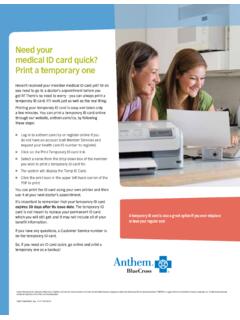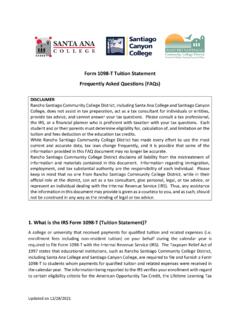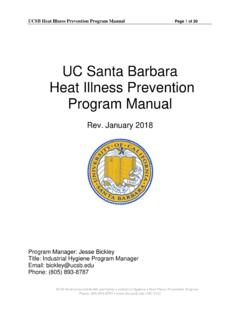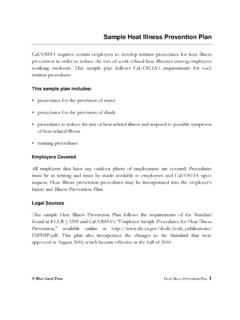Transcription of Heat Illness Prevention Program
1 heat Illness Prevention Program 9/27/10 Policy It is the policy of Rancho Santiago Community College School District that effective and reasonable measures will be taken to protect employees and volunteers from heat Illness and to comply with California Code of Regulations, Title 8, Section 3395. This Program will be integrated into the District s Injury & Illness Prevention Program . Scope This Program will apply to all employees and volunteers whose primary job assignment involve outdoor work and may be exposed to environmental risk factors that could place them at risk of heat Illness . Definitions Acclimatization: The temporary adaptation of the body to work in the heat that occurs gradually when a person is exposed work in a hot environment. Acclimatization peaks in most people within four to fourteen days of regular work for about two hours per day in the heat . Environmental risk factors for heat Illness : The working conditions that create the possibility that heat Illness could occur, including air temperature, relative humidity, radiant heat from the sun and other sources, conductive heat sources such as the ground, air movement, workload severity and duration, protective clothing and personnel protective equipment worn by employees.
2 heat Illness : A serious medical condition resulting from the body s inability to cope with a particular heat load that includes heat cramps, heat exhaustion, and heat stroke. Preventative recovery period: A period of time to recover from the heat in order to prevent heat Illness . Shade: The blockage of direct sunlight. Canopies, umbrellas, and other temporary structures or devices may be used to provide shade. One indicator that blockage is sufficient is when objects do not cast a shadow in the area of blocked sunlight. Shade is not adequate when heat in the area of shade defeats the purpose of shade, which is to allow the body to cool. For example, a car sitting in the sun does not provide acceptable shade to a person inside it, unless the car is running with air conditioning. Responsibilities A. Risk Management: 1. Preparing and maintaining a written Program which complies with the requirements of applicable Cal/OSHA requirements. 2. Assisting with training potentially impacted employees and their supervisors on the risks and Prevention of heat Illness , including how to recognize symptoms and respond when they appear.
3 B. Directors, Managers, and Supervisors are responsible for: 1. Identifying all employees who are required to work outdoors where potential heat Illness could occur. 2. Assuring that adequate water and shade are available at a job site when the environmental risk factors for heat Illness are present. 3. Ensuring that all affected employees have received proper training on heat Illness Prevention . 4. Ensuring that the requirements in this document are followed. heat Illness Prevention Program Page 2 of 3 C. Affected employees: 1. Complying with the provisions of the heat Illness Prevention Program , as described in this document and in the training sessions they attend. 2. Verify they have drinking water available at all times when the environmental risk factors for heat Illness are present and report water supply deficiencies to their supervisor. 3. Verify they have access to a shaded area to prevent or recover from heat related symptoms and report to their supervisor any inadequate shade conditions.
4 4. Reporting heat related Illness symptoms to the supervisor. V. Procedures 1. Employees and volunteer determined to be at risk for heat Illness shall be identified for inclusion into this Program . 2. Training shall be provided for all potentially impacted employees and their supervisors. Training information shall include, but not be limited to, the risks and Prevention of heat Illness , including how to recognize symptoms and respond when they appear. 3. Ample quantities of cool drinking water (one quart per hour per employee) shall be available at all times for each employee for the duration of the entire shift while working outdoors in the heat . Supervisors shall remind employees to drink frequently. 4. Employees shall have access to a properly shaded area to prevent or recover from heat Illness symptoms and where they can take their rest breaks. 5. In the event an employee feels the onset of heat Illness symptoms, a preventative recovery period will be provided to allow the employee to cool down and prevent heat Illness .
5 heat Illness Prevention Program Page 3 of 3 heat STRESS FACT SHEET High temperatures and humidity stress the body's ability to cool itself. heat Illness becomes a particular concern during hot weather. There are three major forms of heat illnesses: heat cramps, heat exhaustion, and heat stroke. heat stroke is a life threatening condition. heat Cramps heat cramps are muscle spasms which usually affect the arms, legs, or stomach. Frequently they don't occur until sometime later after work, at night, or when relaxing. heat cramps are caused by heavy sweating, especially when water is replaced by drinking, but not salt or potassium. Although heat cramps can be quite painful, they usually don't result in permanent damage. To prevent them, drink electrolyte solutions such as Gatorade during the day and try eating more foods that replace lost salt and potassium. heat Exhaustion heat exhaustion is more serious than heat cramps. It occurs when the body's internal cooling system is overworked, but hasn't completely shut down.
6 In heat exhaustion, the surface blood vessels and capillaries, which originally enlarged to cool the blood, collapse from loss of body fluids and necessary minerals. This happens when you don't drink enough fluids to replace what you're sweating away. The symptoms of heat exhaustion include: headache, heavy sweating, intense thirst, dizziness, fatigue, loss of coordination, nausea, impaired judgment, loss of appetite, hyperventilation, tingling in hands or feet, anxiety, cool moist skin, weak and rapid pulse (120-200), and low to normal blood pressure. Somebody suffering these symptoms should be moved to a cool location such as a shaded area or air-conditioned building. Have them lie down with their feet slightly elevated. Loosen their clothing, apply cool, wet cloths or fan them. Have them drink water or electrolyte drinks. Try to cool them down, and have them checked by medical personnel. Victims of heat exhaustion should avoid strenuous activity for at least a day, and they should continue to drink water to replace lost body fluids.
7 heat Stroke heat stroke is a life threatening Illness with a high death rate. It occurs when the body has depleted its supply of water and salt, and the victim's body temperature rises to deadly levels. A heat stroke victim may first suffer heat cramps and/or the heat exhaustion before progressing into the heat stroke stage, but this is not always the case. It should be noted that, on the job, heat stroke is sometimes mistaken for heart attack. It is therefore very important to be able to recognize the signs and symptoms of heat stroke - and to check for them anytime an employee collapses while working in a hot environment. The early symptoms of heat stroke include a high body temperature (103 degrees F); a distinct absence of sweating (usually); hot red or flushed dry skin; rapid pulse; difficulty breathing; constricted pupils; any/all the signs or symptoms of heat exhaustion such as dizziness, headache, nausea, vomiting, or confusion, but more severe; bizarre behavior; and high blood pressure.
8 Advance symptoms may be seizure or convulsions, collapse, loss of consciousness, and a body temperature of over 108 degrees F. It is vital to lower a heat stroke victim's body temperature. Seconds count. Pour water on the victim or apply cold packs. Call get an ambulance on the way as soon as possible. Take these precautions to prevent heat -related illnesses: Condition yourself for working in hot environments. Start slowly then build up to more physical work. Allow your body to adjust over a few days. Drink lots of liquids. Don t wait until you re thirsty! By then, there s a good chance that you re already on your way to being dehydrated. Electrolyte drinks are good for replacing both water and minerals lost through sweating. Never drink alcohol, and avoid caffeinated beverages like coffee and soft drinks. Take frequent breaks, especially if you notice you re getting a headache or you start feeling overheated. Cool off for a few minutes before going back to work. Wear lightweight, light colored clothing when working out in the sun.
9













